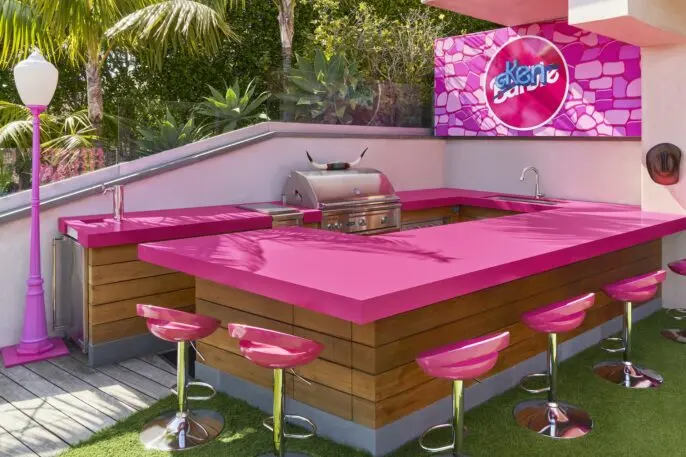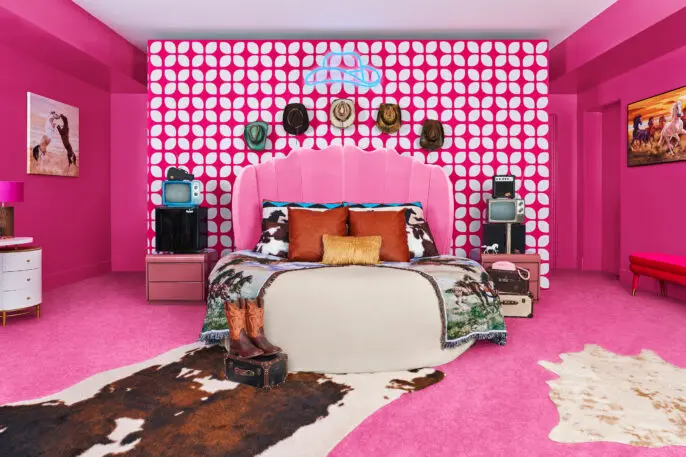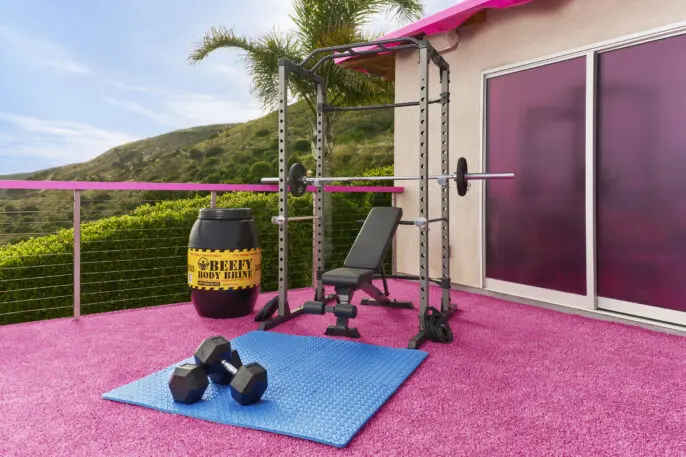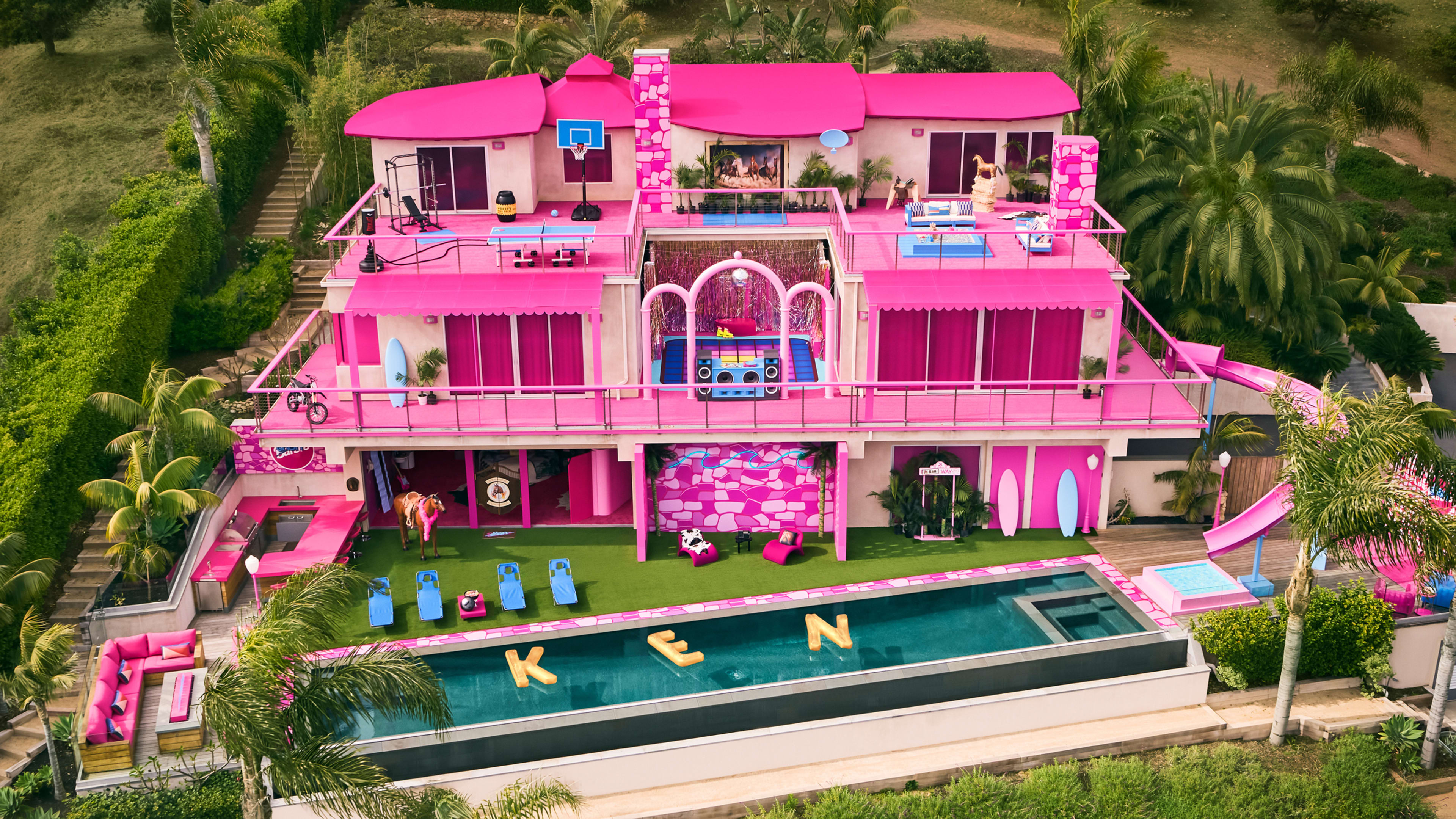A mass of hot pink emerges violently amid the green foliage, palm trees, and shrubbery. Located in Malibu, the oceanfront Barbie DreamHouse created by Airbnb is the latest in a series of global marketing stunts to promote Greta Gerwig’s new film, Barbie, the first live-action adventure movie about the iconic Mattel doll.
A closer aerial shot of the video—uploaded to Twitter by photojournalist John Schreiber—reveals a curved slide, with a small square pool at the bottom. On the pink-and-white wall behind the waterslide, the Barbie logo has been graffitied over with Ken’s name.
The image then cuts to an infinity pool where three giant custom pool floats spell “KEN.” The bird’s-eye view allows us to spy the deep shadows that each letter, swaying gently in the breeze, casts onto the bottom of the pool.
Aerial footage shows the pink palace in stark contrast to the neighboring white mansions. The video ends with two crash zooms, a cinematic technique typical in horror films. The camera zooms in rapidly before quickly zooming out and resuming its god-like surveillance of a house seemingly devoid of human life.
Has Ken killed Barbie?
Airbnb’s life-size DreamHouse, as captured in the video, has a very different feel to trailers for the upcoming Barbie movie. Its unsettling aesthetic is a sharp counterpoint to the thoughtfully curated architectural wonderland that production designer Sarah Greenwood and set decorator Katie Spencer painstakingly created for the film.

My immediate reaction upon watching the footage was: “What has he done with the body? Where has Ken buried Barbie?”
The ominous K–E–N letters floating aimlessly in the deserted pool—Barbie’s silencing through the desecration of her signature, a key marker of her identity—and the terrace furniture enveloped in pallet wrap do not bode well for Barbie.
Airbnb’s official press release confirms that Ken has taken over Barbie’s house, going as far as letting guests check in for free while she is “away.” The reader is not privy to Barbie’s opinion or consent on this matter.

Airbnb classifies Ken’s starring role in this endeavor as a “twist,” because “Barbie is everything, and he’s always been ‘Just Ken’—until now!” It’s a fitting tagline for a revenge horror film.
The grim wording of the press release appears unintentional. Indeed, Airbnb is making a charity donation along with the opening of the DreamHouse “to honor girls’ empowerment.” Why, then, do some of us react to that pink haven with a frisson of anxiety?
Uncanny matters
Airbnb’s topsy-turvy iteration of the DreamHouse evokes uncanny emotions. The uncanny—a state of fear and unease—has been defined in a variety of different, albeit overlapping, ways.
German psychiatrist Ernst Jentsch (1867-1919), thought the feeling arises from the seeming animation of the inanimate or, conversely, the apparent lifelessness of a living being.
Psychologist Sigmund Freud (1856-1939) saw the uncanny in the resurgence of repressed childhood fantasies and primitive beliefs—such as animism, the attribution of a living soul to inanimate things—which challenge adult worldviews.
Japanese roboticist Masahiro Mori coined “uncanny valley” in 1970 to denote the point at which human-like automata (such as robots but also CGI characters) become too lifelike. Uncanny feelings are triggered by their failure to act in a recognizably human manner, despite their appearance.
Through its myriad revisions over the years, the concept’s core idea has remained unchanged: The defamiliarization of the familiar generates ambiguity and temporary disorientation, eliciting a sense of creepiness, dread, or horror.
In this sense, Barbie’s Malibu beach house (in both Airbnb’s and Gerwig’s versions) evokes the uncanny. However, the film relishes its artificiality and uses the uncanny playfully. “Her environment isn’t always three-dimensional, and the scale of everything is a bit off. Barbie is a little too big for her house,” Gerwig told Vogue magazine.

Set decorator Spencer told Architectural Digest that she and production designer Greenwood “adjusted [the] rooms’ quirky proportions to 23% smaller than human size.” It reminded me of American writer Shirley Jackson’s Hill House, which she described as “chillingly wrong in all dimensions.”
The candy-colored mansion is an extension of Barbie and vice versa, central to her identity. Odd proportions, decals paired with 3D objects, and the vivification of dolls paint a portrait, both seductive and unsettling, of Barbie Land. Despite its surrealism, Barbie Land is coated in a fairy-tale veneer that prevents it from becoming terrifying.
On the other hand, Airbnb’s garish dwelling annexes more troublesome elements of the uncanny. It blurs the lines between doll and human along with the boundaries between the real world of California and the fictional realm of the magical dollhouse.
Barbie’s bright-pink plastic fantasy is a disquieting inversion of the gothic Addams Family mansion, rising darkly above the white suburban picket fences. The real-life DreamHouse discloses our borderline vampiric appetite for consuming a piece of someone else’s life—even a doll’s. As children’s literature scholar Anna Panszczyk has observed, “we can never fully occupy the space of our dolls”—but that hasn’t stopped us from trying.
Joana Jacob Ramalho is a lecturer in arts and humanities at the University College London.
This article is republished from The Conversation under a Creative Commons license. Read the original article.
Recognize your brand’s excellence by applying to this year’s Brands That Matter Awards before the final deadline, June 7.
Sign up for Brands That Matter notifications here.
